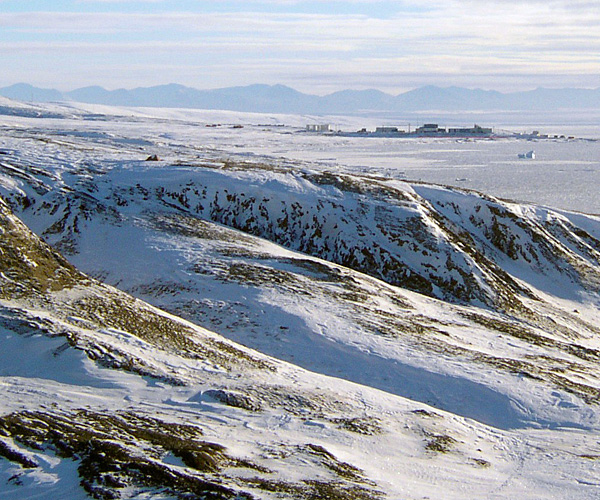Coldest Places in the World
The Polar Plateau of the Antarctic is unquestionably the coldest place in the world. Dome A, the highest point on the East Antarctic ice sheet and the coldest spot there, has an mean annual temperature of -58.3 degrees Celsius (-72.9 degrees Fahrenheit). High-elevation research stations on the plateau also record average yearly temperatures that are below -55 °C (-67 °F).
Along the Antarctic coast, temperatures warm up considerably, with annual means above -20 °C (-4 °F). The rest of the world's coldest places are at the north end of the planet.
The second coldest place in the world also sits at the top of a massive ice cap, this time in Greenland. For the coldest places located on exposed dirt, northern Canada and eastern Siberia top the list.
Greenland's Coldest Places
Like Antarctica's Polar Plateau, Greenland has the exceptionally chilly combination of high elevations rising far from the ocean in the midst of an ice sheet.
At the peak of Greenland's ice cap is the highest point that's above the Arctic circle and the coldest place north of the Antarctic. The top, aptly named Summit, rises to 3,208 metres (10,530 feet) and averages -27.5 °C (-17.5 °F).
Some other weather stations in the center of Greenland's ice cap also record mean annual temperatures below -27 °C (-16.6 °F). At lower elevations and along the coast though, annual means stay above -15°C (5 °F).
Cold Places in Canada's North
Outside of Greenland's ice cap, northern Canada has the coldest places. Eureka, in Nunavut, boasts the country's lowest annual mean temperature of -19.7 °C (-3.5 °F).

Eureka, Canada – one of the world's coldest places. Photo: NASA
Eureka sits by the ocean, part way down a long fiord that winds far into the interior of Ellesmere Island. Without an ice cap to keep conditions frigid year-round, Eureka warms up enough in summer to make its average yearly temperature comparatively mild.
Eureka's exceptionally cold winters drive its annual mean temperature down. Indeed, Eureka has the coldest winter temperatures of any coastal weather station around the Arctic's perimeter, averaging 12 °C (21.6 °F) colder than Chelyuskin and Kotelny on Russia's northernmost islands. Scientists blame the northern Rocky Mountains for influencing air circulation patterns to drag the coldest air over Canada and create a gradient of winter temperatures across the Arctic.
It's not unheard of from December to March for temperatures at Eureka to drop below -50 °C (-58 °F). The coldest month there was February 1979 when the temperature averaged -47.8 °C (-54 °F) and bottomed out at -55.3 °C (-67.5 °F) on Feb 15.
Eureka gets winds of over 100 kilometres per hour (62 miles per hour) during the winter months, enhancing the effect of cold. On Feb 12, 1979, wind combined with the extreme cold to create a wind chill temperature of -69.5 °C (-93.1 °F).
Although 400 kilometres (250 miles) farther north than Eureka, Alert's winters actually average 5 °C (9° F) warmer. Alert, also in Canada, is the northernmost permanent settlement in the world, located at the northeast end of Ellesmere Island, just 817 kilometres (508 miles) from the North Pole.
Summer daily mean temperatures at Alert hover just above freezing, at 1.1 °C (34 °F), several degrees lower than Eureka's. Alert's summers are possibly the coldest anywhere outside of Greenland and Antarctica, giving Alert a respectably low annual average of -18.0 °C (-0.4 °F), and placing it among the coldest places in the world.
Cold Winters of Eastern Siberia
Even Eureka's winters can't compete with those in eastern Siberia, which has the coldest northern winters outside of Greenland. Mountain ranges block central parts of eastern Siberia from ocean air that can moderate temperatures. The region's winters have long nights, clear weather and calm winds, conditions that allow heat to radiate from the ground and escape into the atmosphere.
The weather station that repeatedly records the coldest air in eastern Siberia is at Oymyakon. The coldest winter month in Eureka averages -38.4 °C (-37 °F), while Oymyakon's coldest month averages -46.0 °C (-50.8 °F). Overall, winter temperatures at Oymyakon are 12.5 °C (22.5 °F) colder than Eureka's.
Oymyakon is a village of several hundred people, located in a wide valley, below a plateau surrounded by mountains. The topography causes cold air to sink into the valley bottom where it accumulates.
On an annual basis though, Oymyakon is definitely balmier than Eureka. Because Oymyakon lies considerably farther south, it enjoys warmer summers than the Canadian outpost. As a result, Oymyakon's annual average temperature is -16.0 °C (3.2 °F), several degrees above Eureka's.
References
Environment Canada. Canadian Climate Normals or Averages 1971-2000.
Robert S. Fausto, Andreas P. Ahlstrøm, Dirk Van As, Carl E. Bøggild and Sigfus J. Johnsen. 2009. A new present-day temperature parameterization for Greenland. Journal of Glaciology. 55(189): 95-105.
Paul Krause and Kathleen Flood. 1997. Weather and Climate Extremes. US Army Corps of Engineers, Topographic Engineering Center. Alexandria, Virginia.
James E. Overland, Jennifer Miletta Adams and Nicholas A. Bond. 1997. Regional Variation of Winter Temperatures in the Arctic. Journal of Climate. 10: 821-837.
Weather and Climate. 2010. Climate Oymyakon.
Xiao Cunde, Li Yuansheng, Ian Allison, Hou Shugui, Gabrielle Dreyfus, Jean-Marc Barnola, Ren Jiawen, Bian Lingen, Zhang Shenkai and Takao Kameda. 2008. Surface characteristics at Dome A, Antarctica: first measurements and a guide to future ice-coring sites. Annals of Glaciology. 48(1): 82-87.